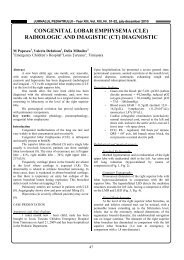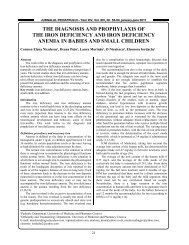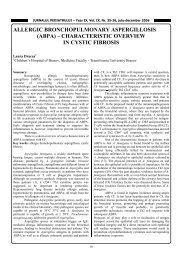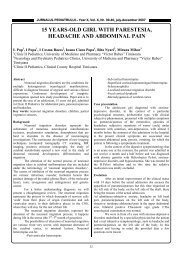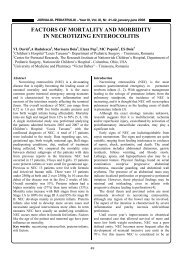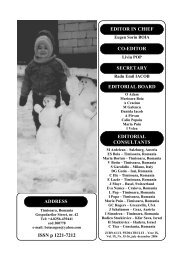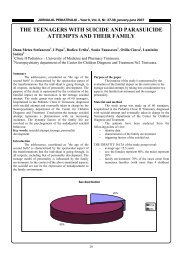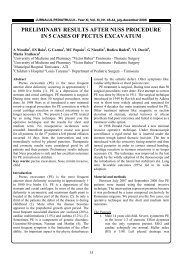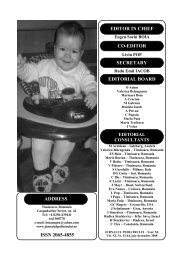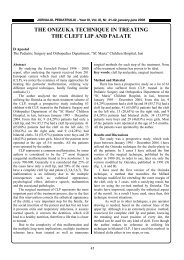address editor in chief co-editors secretary editorial board
address editor in chief co-editors secretary editorial board
address editor in chief co-editors secretary editorial board
You also want an ePaper? Increase the reach of your titles
YUMPU automatically turns print PDFs into web optimized ePapers that Google loves.
Muazez Cevik 1<br />
JURNALUL PEDIATRULUI – Year XV, X<br />
, Vol. XV, Nr. 59-60<br />
60, , july<br />
j<br />
uly-december 2012<br />
UNUSUAL PRIMARY HYDATID CYST FROM<br />
SOFT TISSUE IN CHILDREN: FOUR CASES<br />
AND REVIEW OF LITERATURE<br />
Abstract<br />
Objective: Hydatid cyst (HC) is a zoonosis caused by<br />
the larval stage of the Ech<strong>in</strong>o<strong>co</strong>ccus tapeworm. The location<br />
of HC is usually hepatic and/or pulmonary. In the present<br />
study was evaluated 4 patients with primary HC (PHC)<br />
related the literature. The present first the largest series of<br />
PHC of the soft tissue <strong>in</strong> the literature<br />
Cases and Presentation: An experience of a s<strong>in</strong>gle<br />
surgeon was <strong>co</strong>nducted of 4 cases of primary HC of unusual<br />
regions of the body treated between 2004 and 2011.<br />
Locations were axillary fossa, popliteal fossa , and thoracic<br />
wall . Patients were admitted with an <strong>in</strong>itial diagnosis of<br />
lipoma, lymphadenitis, or other cystic lesions. The<br />
def<strong>in</strong>itive diagnosis of PHC was made peroperatively and<br />
related histopathological exam<strong>in</strong>ation.<br />
Conclusion: A PHC disease should be <strong>co</strong>nsidered <strong>in</strong><br />
the differential diagnosis of cystic lesions <strong>in</strong> every anatomic<br />
location, especially when patients have spent time <strong>in</strong><br />
endemic areas for HC.<br />
Key words: Hydatid cyst; primary; soft tissue; children;<br />
ech<strong>in</strong>o<strong>co</strong>ccus<br />
Introduction<br />
The term “hydatid” has Greek orig<strong>in</strong>s and means<br />
“watery vesicle.” Human ech<strong>in</strong>o<strong>co</strong>c<strong>co</strong>sis was first described<br />
<strong>in</strong> ancient times by Hippocrates as “cysts full of water” <strong>in</strong> a<br />
human liver. 1,2 . There are six species of Ech<strong>in</strong>o<strong>co</strong>ccus<br />
tapeworm, <strong>in</strong>clud<strong>in</strong>g E. granulosus (which causes cystic<br />
ech<strong>in</strong>o<strong>co</strong>c<strong>co</strong>sis), E. multilocularis (which causes alveolar<br />
ech<strong>in</strong>o<strong>co</strong>c<strong>co</strong>sis), E. vogeli and E. oligarthus (which cause<br />
polycystic ech<strong>in</strong>o<strong>co</strong>c<strong>co</strong>sis), E. shiquicus, and E. felidis. E.<br />
granulosus is the most <strong>co</strong>mmon Ech<strong>in</strong>o<strong>co</strong>ccus parasite to<br />
<strong>in</strong>fect man. 3 Dogs are the primary host of ech<strong>in</strong>o<strong>co</strong>ccal<br />
<strong>in</strong>fection, while <strong>in</strong>termediate hosts <strong>in</strong>clude sheep, cattle,<br />
and, occasionally, man. Hydatid cyst (HC) is most often<br />
found <strong>in</strong> rural areas. 4,5 . HC is endemic <strong>in</strong> Mediterranean<br />
<strong>co</strong>untries, the Middle East, Far East, and south America. 2,6<br />
Primary HC (PHC) from soft tissue is very rare.<br />
Despite several important advances <strong>in</strong> the <strong>co</strong>ntrol of<br />
HC, this disease rema<strong>in</strong>s a major health problem <strong>in</strong> some<br />
<strong>co</strong>untries. The PHC located <strong>in</strong> extremely rarely is seen <strong>in</strong><br />
soft tissues even <strong>in</strong> which ecch<strong>in</strong>o<strong>co</strong>ccal <strong>in</strong>festation is<br />
frequent. In this report were reported to four rare cases had<br />
PHC <strong>in</strong> soft tissue as an un<strong>co</strong>mmon site and review the<br />
literature.<br />
Material and Methods<br />
The medical re<strong>co</strong>rds of unusual presentation primary<br />
HC as subcutaneous were reviewed. In addition, the English<br />
language literature was reviewed. We retrospectively<br />
identified all cases of HC managed by the pediatric surgery<br />
department at Sanliurfa public hospital, Sanliurfa, Turkey, a<br />
fund<strong>in</strong>g hospital, Mombasa, Kenya, Harran University,<br />
Medical Faculty hospital, Sanliurfa, Turkey dur<strong>in</strong>g the<br />
years 2004 to 2011 (Table 1).<br />
Table 1: Demographics and cl<strong>in</strong>ical features <strong>in</strong> patients related literature<br />
Cases Age/ Rural Symptom Location of HC Previous Diagnosed with<br />
Gender enivorment<br />
diagnosis<br />
Cangiotti L, et al 10 Yes Mass Lumbar No After Surgery<br />
Nath K et al. 8 12/M Yes Mass Neck No After Surgery<br />
Marwah S et al. 12 8/M Yes Mass the tigh Yes USG, serology<br />
Duygulu F, et al. 13 8/F Yes Mass The wall of Yes<br />
MRI<br />
thoraxThorax<br />
Erol B, etal. 6 Mass tissue of calf mass Yes MRI<br />
Ok E et al. 5 12/f unknown Mass neck No After Surgery<br />
Cankorkmaz L et al. 7 4/M No Mass lumbar Yes MRI<br />
Gupta R et al. 2 12/F Yes Mass Shoulder No Needle aspiration<br />
Arslan S et al. 11 5/M No Mass Lumbar Yes USG<br />
Our Case 1 7/F Yes Mass Left axillar fossa No After Surgery<br />
Our case 2 11/F Yes Mass Right ant thorax wall No After Surgery<br />
Our case 3 4/M Yes Mass Popliteal Fossa No After Surgery<br />
Our case 4 6/M Yes Mass Left axillar Fossa No After Surgery<br />
1 Department of Pediatric Surgery Harran University Faculty of Medic<strong>in</strong>e, Sanliurfa, Turkey<br />
E-mail: cevikmuazzez@gmail.<strong>co</strong>m<br />
18



